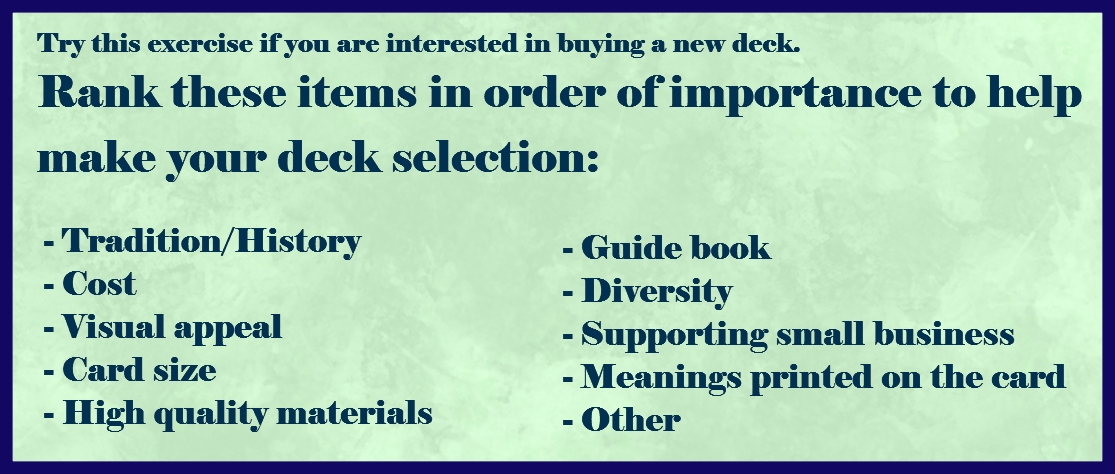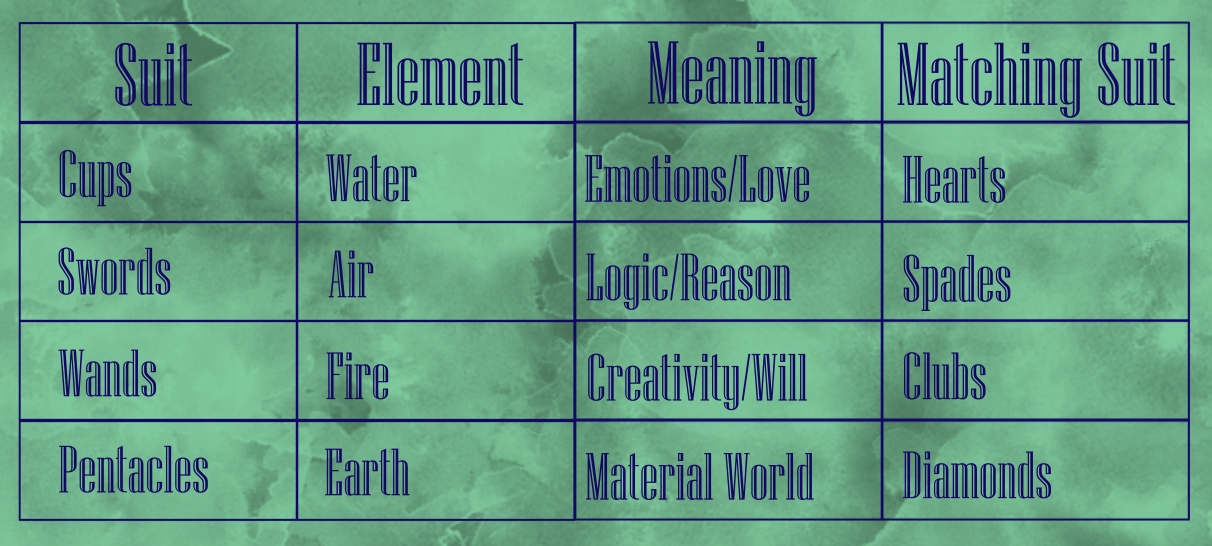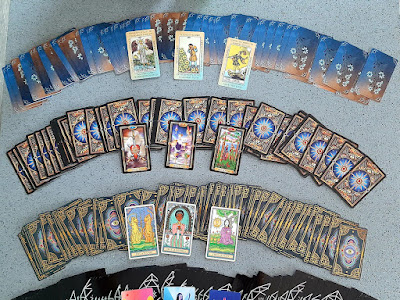Welcome to the wonderful world of tarot! Tarot has a long history and is frequently credited for bringing popularity to card games in Europe several centuries ago. Originally a parlor game, tarot later became a tool for divination. What will tarot mean to you? Will you think about it the next time you play Uno and wonder if that game would have existed with tarot? Will you use the cards for an entertaining night with friends? As a tool for self-reflection? Let’s get started and find out! 78 Card Tarot Deck (free and affordable printables are available online and through phone apps if desired)
Choosing a Deck
There are as many deck types as there are interests. Geeky, classic, simple, artistic – find a deck that speaks to you. There are free apps like Galaxy Tarot that can be used for readings or for learning card meanings. Free or affordable printable decks are available in online stores like Etsy and on tarot blogs. Amazon has affordable variety and Kickstarter is a platform where many independent artists promote their dream decks (BTW, The Literary Tarot on Kickstarter is going to be amazing). Some decks even have the key word meanings printed right on the card – I’m looking at you, Wandering Star deck! On a personal note, I like to consider diversity and inclusion when selecting a deck. I quickly realized after obtaining my first two decks that, though lovely, they were quite shallow in their representations of humanity.

Guidebooks
If you purchased a deck it likely came with a guidebook. There are also card descriptions available in many places online, like Wikipedia or on tarot blogs, and in free phone apps. To do a reading you will need a guide of some kind so that you can determine card meanings. The interesting thing about this is that each guidebook is slightly different, so really you could make your own meanings from looking at the pictures and you likely will not be far off! Guidebooks are also available at most libraries and book stores if you want to expand.
A quick note about reverse cards as they can be confusing in guidebooks: When a card comes out upside down in a reading it is considered “reversed.” Some people include reverse meanings in their readings and others do not. I personally find enough meaning in the upright cards that I do not use reverse meanings in my readings, but this is an entirely personal preference.
Taking Care of Your Deck
There are many superstitions and practices around caring for tarot decks. Some people believe no one but the owner should ever touch the deck while others think the person being read must touch the cards. Some wrap their cards in cloth or in a fancy bag while others store them in whichever box they came in. Cleansing the deck between uses, sleeping with cards under one’s pillow, never letting a deck touch a surface without a cloth barrier; the list goes on and on. Again, do what feels right to you. My practices change depending on how I am feeling and what the situation is. Personally, I prefer to use whatever will help me put distractions aside and focus on the present moment. Longer prep time and engaging the senses certainly help with this.
Anatomy of a Deck
The 78 card deck that is most common is divided into two groups: Major Arcana and Minor Arcana. Major Arcana cards are numbered 0-21 and are the trump cards in the deck. These are the cards most often referenced in popular culture such as Death, The Magician, Lovers, etc. It can be easiest to learn these cards first if a deeper dive into tarot is wanted.

Minor Arcana cards are divided into four suits: cups, wands, pentacles, and swords. There are cards numbering 1-10 and four court cards in each suit. The Minor Arcana cards correspond very closely with the playing card decks most of us are familiar with today, with Jokers taking the place of the fourth court card. There is A LOT of information out there on card meanings, intuitive reading, memorization tricks, reading options, and the story arcs of the Major Arcana and individual suits. My recommendation is to find a guidebook, website, or app that you like and stick to one source to start with when learning. Otherwise it can become quickly overwhelming.
Getting Started
First things first: before doing a reading keep in mind that there are no “good” or “bad” cards in a deck. Meanings depend on many factors including the question asked, the position of the card, and the relationship to surrounding cards. Some cards like The Devil and Death get a bad rap, but really are not intended to mean that Satan or the grim reaper are coming to your door. Thanks for that misunderstanding, pop culture!
Once you have your deck and a guidebook (or website) you are set to get started. Find a quiet place where you can concentrate and be open to whatever rituals come to mind to help you get focused. Think about what you would like to accomplish with this reading or consider a specific question. Focus on this intent during your entire setup process. You can speak it out loud if that helps your focus.
Shuffle your deck and consider how the cards look and feel in your hands. I do not recommend shuffling them in the way people often shuffle playing cards as this can damage tarot decks that are not designed to be handled in that way. Take your time shuffling the cards then cut the deck into three piles. The piles do not need to be equal. Let the cards divide in whatever way feels right. If you get a nudge to do two or four piles, do two or four piles. Restack the cards in reverse of how they were divided. You are now ready to draw. You can select cards from the top of the deck and lay them face down in front of you, or you can fan out the cards on the table and then select them one by one. If you get a card that “jumps” out from the rest during this process, consider using that card in your reading.
I recommend starting with single card draws. These are great for a variety of purposes, including getting familiar with your deck. Many people like to keep a record of their readings in a journal. This is an especially good idea if you are going to do more than one draw in a row. If doing multiple readings in a day, make sure to start back at the beginning and consider your new question or intent before drawing again.
Please feel free to reach out to me on Discord with questions. Happy reading until tomorrow!
Contributed by Beth aka Phoenix Emerald
Beth, aka PhoenixEmerald, spends half her time swimming in the science of the real world and the other half flying in a bookshelf time machine with her pet dragon, Gideon. Crafting, traveling, tarot, tabletop games, and books are always on Beth’s list of geeky loves. Find her on Instagram at @PhoenixEmeraldTarot.






[…] a tarot card deck (purchased, printed, or app) and guidebook or website with meanings. (Check out yesterday’s post for a deeper dive in picking a deck, […]